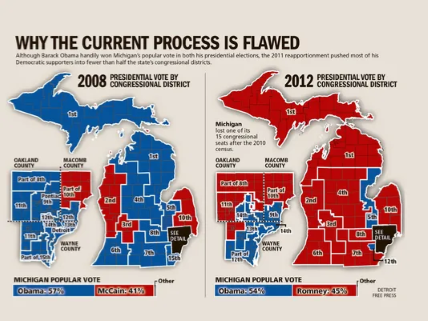
The Census is one of the most important democratic processes in our country. It creates the foundation for the electoral college, which awards representation based on population by state. However, once these numbers are received, districts may need to be redrawn to account for increases or decreases in population, causing a change in the number of districts. In most states, this duty falls to state legislatures, clearly a partisan process vulnerable to manipulation, as legislators are incentivized to draw lines favorable to their party for decades to come to keep winning elections.
For Michiganders, proof of this process has been delivered in the form of a federal court ruling that 34 of Michigan’s Congressional and legislative districts are unconstitutional and need to be redrawn prior to the 2020 election. The districts are so grotesquely out of order, the legislature needs to submit redrawn districts by August of this year. Coming up on another Census year, it is important to understand how this happened, and the effects of this phenomena on Michigan over the past decade.
The year 2010 was a huge year for Republicans. Obama’s Democratic Party took heavy losses that year, especially in state governments, which included the state of Michigan, in which Republicans won the governorship, flipped the house, and installed a Republican secretary of state, who oversees the elections. The Census was conducted earlier that year, so new lines had to be drawn to eliminate an election district due to a loss in population. With a Republican majority across the board, they had a blank check to pass whatever maps they wanted, as they knew the governor would authorize the maps to keep him and his colleagues in power. The graphic above does an excellent job explaining how they accomplished their goal.
In 2008, twelve out of fifteen districts in Michigan elected Democratic representatives. The maps were redrawn according to the census, riding on a nationally poor election for Democrats without Obama actually on the ballot, leaving many base Democratic voters at home. Then came 2012, when, as you can see, Michigan saw only a 3% decrease in support for Obama. Nine of the fourteen districts went to Republicans. Of course support went down a little, but to see such a substantial change from such a small difference in percentage is unreal. Three percentage points is within the margin of error of most polls, so how could it flip a majority like that? There is one explanation: gerrymandering.
Using their powers to redraw districts, “packing” and “cracking” were used to ensure a Republican majority. The process of “packing” means that several likely voters for one particular party are looped into one district. Look at the 1st Congressional District in 2008, and see how it changed in 2012. The Upper Peninsula of Michigan is highly conservative, yet has a very low population, so northern Michigan is also located within the 1st District. As a general rule, Michigan voters get more Democratic the closer to Detroit (southeastern Michigan) you travel, along with most other metropolitan areas. So, how could the Republicans flip a few districts? They likely packed Democratic voters into 2012’s new 5th District, cutting out Democratic parts of the 1st and 4th Districts. Not too terribly difficult to do, and not too terribly difficult to find. However, only now are we seeing courts rule in favor of rectifying these issues.
Democrats have used these same strategies, but less often. According to The Washington Post, in 2016, “Republican candidates won 37 percent of the statewide two-party vote for U.S. House seats. But because of the way Democrats drew district boundaries after the 2010 Census, that translated to just one of the state’s eight House seats.”
So, ahead of another Census, what are the important takeaways from this story? Well, look at Michigan before and after 2010. In 2008, Michigan went to Obama by a margin of nearly twenty percentage points. In 2012, that gap narrowed to ten percentage points. In 2016, Trump won Michigan. In less than a decade, the state went from Obama to Trump. This still puzzles political scientists and pollsters today, but there are a few potential explanations. Voter turnout has been trending downward since 2008, which could stem from frustration with the political system. Frustration economically since the Great Recession, when the auto industry was hit hard, could explain a turn to the party that has a reputation of being more conservative economically in times of economic hardship.
But, most importantly, if you know that your district is historically more favorable to the other party, are you really going to feel motivated to vote. In the 13th District, Representative Rashida Tlaib ran unopposed by a Republican, winning nearly 85% of the vote. If you were conservative in that district, would you feel your vote really matters?
Michigan, through a ballot measure, has approved of non-partisan redistricting by commission, a process practiced by Arizona, California, and Hawaii. Four Democrats, four Republicans, and five independents who hold no public office and do not receive money for any campaign or partisan cause will draw the lines in 2021.
Hopefully, this will restore confidence in the system, but severe damage has already been done to the state by this manipulation of democracy for partisan gain. Only time will tell if trust can be restored, but the future looks bright for a state that is aware enough to approve the ballot measure to combat gerrymandering.









